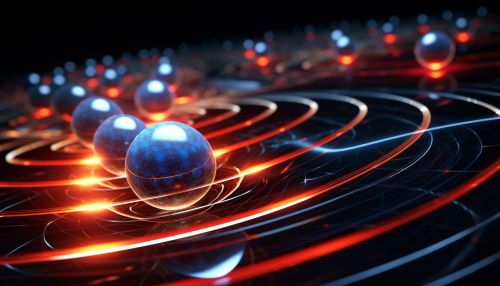Bose-Einstein statistics
Introduction
Bose-Einstein statistics is a statistical law in quantum physics that describes the behavior of a collection of identical and indistinguishable particles known as Bosons. This law was first proposed by Satyendra Nath Bose in 1924 and later generalized by Albert Einstein.


Overview
Bose-Einstein statistics applies to particles with integer spin, or bosons. This is in contrast to Fermi-Dirac statistics, which applies to particles with half-integer spin, or Fermions. The fundamental difference between the two is that while fermions obey the Pauli exclusion principle, which states that no two fermions can occupy the same quantum state simultaneously, bosons do not. This allows bosons to occupy the same quantum state, leading to phenomena such as Bose-Einstein condensate and superfluidity.
Mathematical Formulation
The mathematical formulation of Bose-Einstein statistics is based on the concept of quantum states. In a system of non-interacting bosons, the number of ways that N particles can be distributed among g quantum states is given by the formula:
(1) N! / [n1! n2! ... ng!]
where n1, n2, ..., ng are the occupation numbers of the states, such that the sum of all ni equals N. This formula is derived from the principles of combinatorics and represents the number of permutations of N particles among g states.
Bose-Einstein Condensate
A Bose-Einstein condensate is a state of matter that arises when bosons in a gas are cooled to temperatures very close to absolute zero. Under these conditions, a large fraction of the bosons occupy the lowest quantum state, resulting in macroscopic occupation of a single quantum state. This phenomenon was first predicted by Bose and Einstein, and was observed experimentally in 1995 in a gas of Rubidium atoms.
Superfluidity
Superfluidity is another phenomenon that arises from Bose-Einstein statistics. It is a state of matter in which matter behaves like a fluid with zero viscosity. This allows it to flow without losing kinetic energy. Superfluidity occurs in liquid helium when it is cooled below a critical temperature, and is also observed in Bose-Einstein condensates.
Applications
Bose-Einstein statistics has found applications in various fields of physics, including solid state physics, quantum optics, and astrophysics. In solid state physics, it is used to describe the behavior of photons in a black body, and the behavior of phonons in a crystal lattice. In quantum optics, it is used to describe the statistics of photons in lasers. In astrophysics, it is used to describe the behavior of certain types of stars, such as white dwarfs and neutron stars.
See Also
Quantum Statistics Quantum Mechanics Statistical Mechanics
